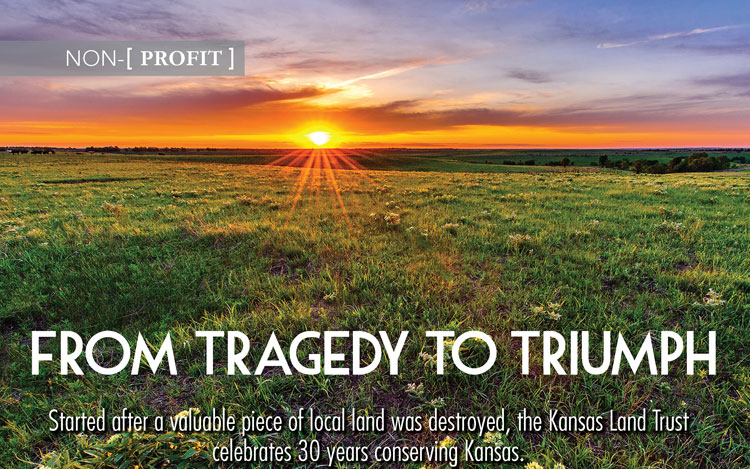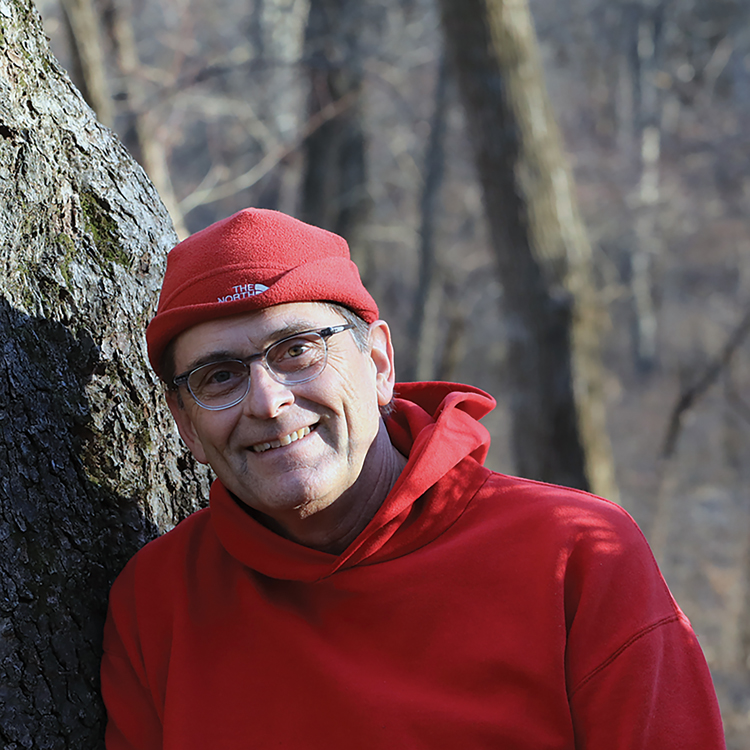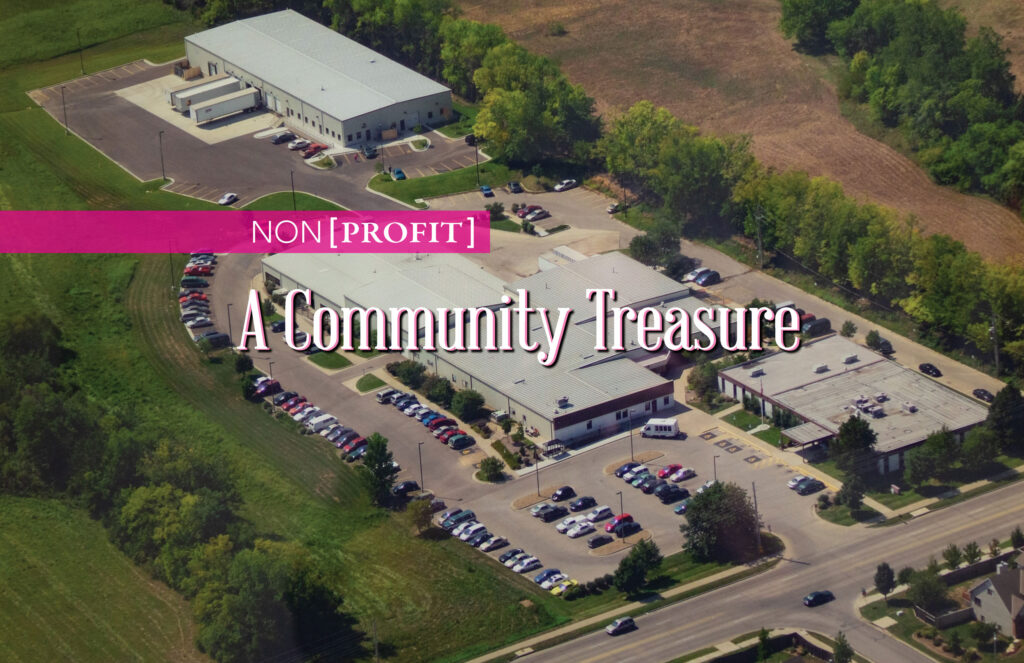FROM TRAGEDY TO TRIUMPH
Started after a valuable piece of local land was destroyed, the Kansas Land Trust celebrates 30 years conserving Kansas.
| 2020 Q1 | story by Liz Weslander

Red Buffalo, photo_by_Bruce_Hogle
During the dark, early hours of a November morning in 1990, a valuable piece of local natural history was lost forever.
The Elkins Prairie was a 70-acre tract of virgin tallgrass prairie just west of Lawrence that, 30 years ago, fell into the hands of a landowner who, despite requests from the city, county, and local advocates to preserve the land, decided to plow it up.
“This was the largest remaining prairie in the county. It had incredible ecological diversity that was thousands of years in the making,” explains Jerry Jost, executive director of the Kansas Land Trust (KLT). “One plow ruined all that. It took away all of the biological and ecological value of that land.”
Fortunately, the tragic plowing of the Elkins Prairie ended up having some positive impacts. A group of people who had witnessed the prairie’s destruction committed themselves to figuring out ways to prevent something like this from happening again. Working with the Kansas Legislature, the group helped push through legislation that made land trusts possible in the state of Kansas. With this legislation in place, the Kansas Land Trust was born.
“Thirty years ago, there were no land trusts in Kansas, and we couldn’t protect something like the Elkins Prairie; but today we can,” Jost says. “Thirty years hence, the Kansas Land Trust has protected almost 40,000 acres on 77 parcels of land in 22 counties. That’s a conservation footprint that is comparable to the size of Topeka.”

Jerry Jost, Executive Director of the Kansas Land Trust
The Kansas Land Trust is one of thousands of land trusts across the U.S. and one of a handful in the state of Kansas. The way land trusts protect land is through the creation of conservation easements. A conservation easement is a voluntary partnership and legal agreement between a landowner and a conservation organization that limits future development of the land.
“An easement means that we, as a land trust, simply hold development rights on a piece of property,” Jost says. “We don’t own that land, and we don’t manage that land. But, we do hold and lock in the land uses of that land, so that we can protect what makes that land special.”
The Kansas Land Trust’s easements protect and preserve lands of ecological, agricultural, scenic, historic or recreational significance. Once an easement is established on a piece of land, the Kansas Land Trust holds the development rights in perpetuity—meaning forever.
“If we protect a prairie, it will never be plowed,” Jost explains. “If we protect a woodland, it will forever stay a woodland. If we protect a piece of prime farmland, it will stay a working farm and never be turned into a business park or subdivision.”
In 1994, the Kansas Land Trust permanently protected its first piece of land, a 16- acre native wildflower prairie in southeastern Douglas County called the Akin Prairie. The landowner, Tom Akin, worked with the Kansas Land Trust to protect the prairie as a tribute to his late wife, who loved wildflowers. At least 218 plant species have been identified on the biologically diverse prairie. Kelly Kindscher, a founding member of the Kansas Land Trust and senior scientist for the Kansas Biological Survey, leads public wildflower walks on the Akin Prairie every summer.
“Akin is a gem of a native tallgrass prairie remnant,” Kindscher says. “Its diversity of plant species makes it a window to the past. People who visit are always struck by the amazing variety of wildflowers there.”
The Kansas Land Trust currently protects 77 parcels of land in 22 counties across Kansas. Eleven of those parcels are in Douglas County.
The Lawrence Nature Park, 201 Folks Rd., a 100-acre park that offers 3 miles of woodland hiking trails, is a great example of how landowners and land trusts can partner with cities to create public access to nature. The idea for the park came about in the mid-90s, when Bob and Betty Lichtwardt expressed interest in protecting 40 acres of woodlands that they owned on what is now the Lawrence Nature Park.
“The Lichtwardts loved those woodlands,” Jost says. “And, they saw that Lawrence was developing up and around them. They decided they wanted to protect those woodlands so that they would stay as a natural green space in the middle of the growing city.”
Through the Kansas Land Trust, the Lichtwardts put a conservation easement on the woodland property in 2001, then they gave that land to the City of Lawrence to develop into a park. The city then bought land adjacent to the easement and created trails on the 100 acres of green space.
“It’s a partnership between us—the land trust—that holds those development rights that save those woodlands and the City of Lawrence, who owns and manages and maintains the trails, and creates access for all of us to get outdoors while we are in the middle of the city,” Jost explains.
The Kansas Land Trust is celebrating 2020, its 30th-anniversary year, with a variety of events that aim to honor their past and invest in their future. Throughout the year, KLT will host walks on their protected lands.
“We want to give the friends of the Kansas Land Trust the chance to walk on both private and public land that has been protected by the Kansas Land Trust,” Jost says. “Walks will be a fraction of a mile up to several miles. We hope to have the opportunity for folks to walk a total of 30 miles on protected lands.”
Sticking with the “30” theme, KLT will be running a campaign to raise $30,000 over the summer and will host a “30th With Friends” party on July 24 at the Cider Gallery, 810 Pennsylvania St. It is also developing a 30-day “Naturalist in Training” summer activity for families looking to connect with the local landscape. Another important part of the anniversary year is thinking and talking about what the next 30 years will look like for the Kansas Land Trust.
“I hope we have conversations in the community throughout this year about our vision for 30 years from now,” Jost says. “What special places do we want to protect? What kind of increased access do we want give to people to get outdoors? How do we engage the youth in being conservationists and experiencing the outdoors? How do we nurture the next generation of leaders? I think we also need to think about how we become a solution to our changing climate and how we help sequester carbon so that we can extend a good life and bountiful nature to all future generations.”




